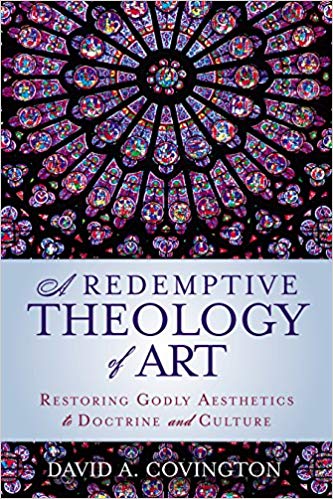David A. Covington
Grand Rapids: Zondervan, 2018. 233 pages. Softcover. $24.99.

Reviewed by Eamonn M. Ferguson on 06/07/2019
Anthony Esolen speaks truth when he laments that modern Christians “are starved for beauty.”[1] David Covington concurs, and in his work A Redemptive Theology of Art seeks to offer his proposed solution to the current drought. He seeks to address what he believes to be a “separation of doctrine from aesthetic standards” (18). He does this through a systematic approach to the biblical teachings regarding human passions and their relationship to aesthetics. Covington claims that his system advances this theological discussion, which, he asserts, has only produced mixed or incomplete results in the past. While he does not seek to innovate, he does find his research to be somewhat pioneering. He notes that few thinkers “have attempted a systematic theology of aesthetics, or to locate aesthetics within systematic theology” (23).
Covington’s work is not considered pioneering however, he does present an interesting perspective on the issues of art, aesthetics, and the objectivity or subjectivity of beauty that bear further discussion. Covington speaks of such things as being rooted in divine observance. God creates beauty, sees it, and reacts to it—that which God says is good must be so, and that upon which God turns his back cannot be. Aesthetics and the tension between beautiful and ugly are found throughout Scripture, from the language of Scripture to the events, descriptions, and personalities this language depicts. All that is comes from God. Therefore, formlessness is bad while completed creation is good and beautiful, for “God himself is the aesthetic ultimate.” (57) Since man is created in God’s image, he also sees and reacts to the beautiful or the unbeautiful. Yet, Covington asserts, man’s ability to do so only exists in so far as man is aligned with God. What God sees as beautiful man also deems to be beautiful. This does not refer simply to that which is seen, but all that is. Therefore, true aesthetics are seen and appreciated when man lives according to the will of God, in communion with God and in love to the neighbor. From such relationships is born true beauty, and from the corruption of such relationships (i.e., from sin) is born true ugliness. This is, perhaps, the most insightful point Covington makes.
There are many similar insights throughout this book, some of which are profound and others repetitive. However, many of these insights are worth the read, though perhaps not worth the effort it takes to locate them. This underscores the chief weakness of Covington’s work: he tries to accomplish too much. The breadth of his discussion necessitates generality rather than the specificity one would expect from the title of his work. The pacing also suffers from an excess of peripheral ideas, and unnecessary, and at times plodding, repetition. Logical argumentation often gives way to argument by analogy, which, Covington asserts, “has, for some of us, more power to persuade intuitively than has logic alone” (25).
For those interested in beauty and aesthetics Covington’s work is an excellent introduction to the subject matter, and for that he is to be commended. He presents some interesting concepts and ideas that will certainly bear fruit given more time and more focused study.
[1] Anthony Esolen, Out of the Ashes: Rebuilding American Culture (Washington, D.C.: Regnery Publishing, 2017), 36.



